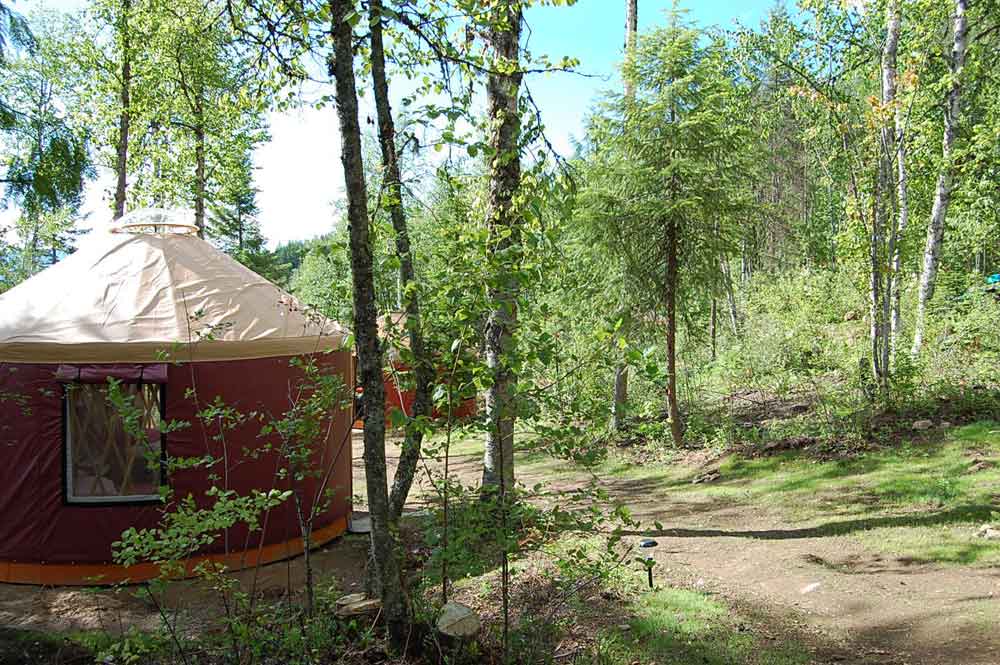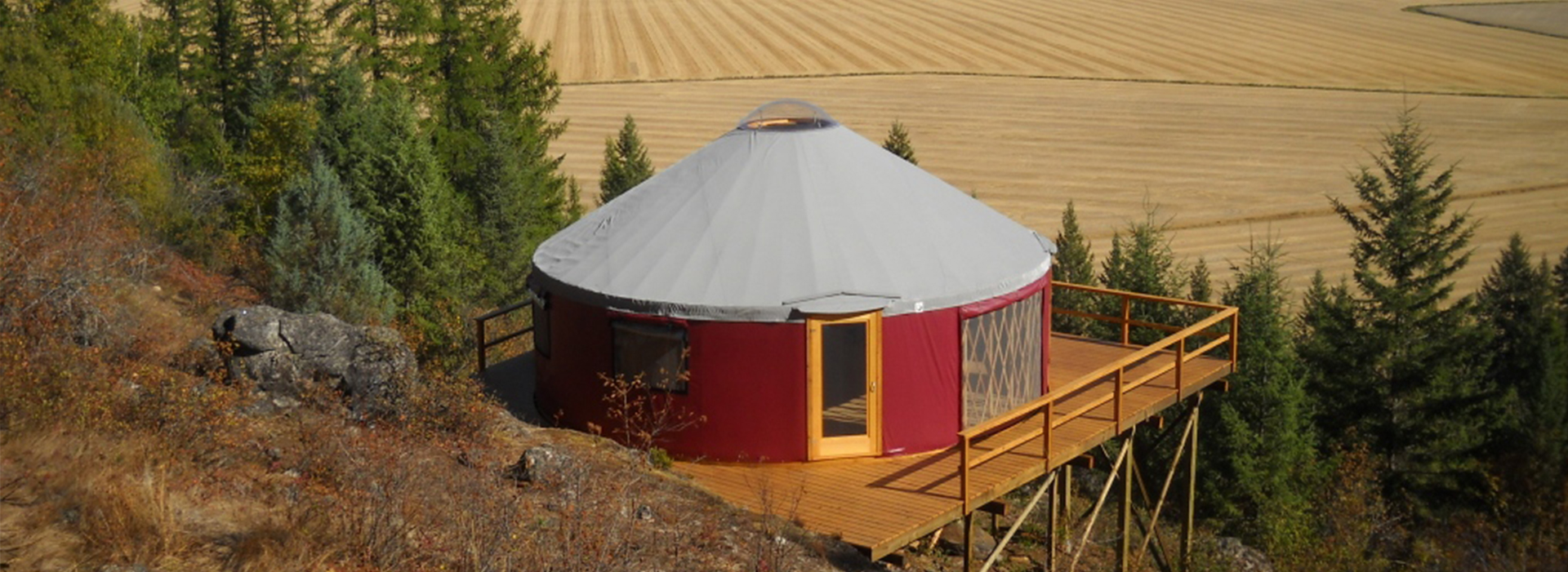
In the market for your very own yurt house? There is nothing more liberating than making and realizing long term plans, and having the vision required to get you to your goals. At Shelter Designs, we saw the need for environmentally responsible shelters and went from there. Many of our business days are spent crafting the wooden components for your yurts. We craft each and every door and window frame, piece of lattice, rafters, center hubs, snow and wind kits here in the shop: focusing on quality, no factory items here!
One of the main pillars of our business has been, and will remain to be great custom service. We also have the goal of being the best yurt manufacturer in the industry. Both of these principles require listening to our customers, adapting our yurt designs to be better, and providing whatever support our customer’s need to be successful. I can’t tell you how many hours we spend with each customer, but it is usually a lot.
However, there are times when you come to a fork in the road. We have found a very unusual fork facing us, one that we never imagined would be there. We want our customers to be thrilled with the yurts we make and find ourselves writing the following post, in the hopes that it reaches you before you buy a yurt house. We hope you find these ideas helpful.
Here Are 10 Reasons A Yurt House May Not Be Right For You!
- You do not like polyester or vinyl.
- You are expecting them to perform like a stick-framed house.
- You want your home building to be easy and straightforward.
- You value your privacy above all, and you have 5 children.
- You have REALLY loud traffic, loud neighbors, loud fights with your spouse, or overhead jets.
- You hate dealing with the local government.
- You live in a very hot or cold environment.
- You want to live off grid, but need/want to be as comfortable as when you lived in your on-grid house with running water, flush toilet, and electric heat.
- You have no savings or assets.
- You don’t have land.
BONUS: Maybe you’re asking yourself what is a yurt?
Or maybe we’re a perfect match! Read on to learn more about yurt life and Shelter Designs’ yurts for sale!
1. You do not like polyester or vinyl.
I know, it was a very big fad in the 70’s. If you avoid polyester and vinyl at all costs, you will not appreciate that our fabrics use both. From our standpoint, these materials have the longest life, and they are strong enough to hold up to the UV, weather, and mold challenges that any structure can have. Our fabric cover manufacturer: Reliable Tent and Awning, uses cutting edge fabric welding that only works on these materials. This makes the seams of the fabric covers much more sturdy, and less likely to fray or unravel. While we sometimes quote for different insulation fabrics, and liners, the cold hard truth is that vinyl works best for your investment.
2. You are expecting them to perform like a stick-framed house.
Let’s face it, humans don’t like to have limits to what they can do, and where they can live. Look at Phoenix, AZ for example! We spend a lot of resources keeping our homes at 65-70 degrees year round. Here in North Western Montana that usually looks like 4-6 cords of wood for the wood stove, or $500+ on propane, or $225 a month on electric heat. These are the “prices” we pay to live in a beautiful part of the country. In the summer, many people do not have central air conditioning and often use fans, air units, or jumping in the river to cool off. People ask us whether they can stay warm in a yurt?? The answer is yes, of course you can. How much energy you use is related to your yurt set up, and how much yurt insulation you have, and what your heat source is. We developed the Arctic Insulation to increase the ability of our yurts to retain heat. Do not buy a yurt house if you are not interested in drops in temperature when your stove goes out, the fact that you may have to stoke your stove at night, or that you may need to wear slippers in the coldest days of winter. In Montana, these are all things that are very much a part of life, but think hard if you really want to live in an insulated “tent” . Our yurts perform very well under many different conditions, provided you remember what they are, and they are not.
3. You want your home building to be easy and straightforward.
Many folks initially think of a yurt like a tent: you can just pop one up! However, our yurt design has been highly engineered to be safe and stable and this means you will be constructing a yurt platform. Depending on the site, and what utilities you are bringing in you will have to organize (or hire a general contractor) for excavation, building permits, many different contractors for the different aspects of the platform build. Then there is the yurt assembly! Next is the interior build out! If you would prefer to have all of these things done already, a tiny home may be a better option for you.
4. You value your privacy above all, and you have 5 children.
It is very nice to make dinner while chatting with your husband in the living room. However if you are writing your dissertation, work from home with little kids, or work the night shift and have a teenager who loves the drums you may not enjoy the sharing. Yes of course you can frame in a bedroom, and bathroom! Will the children having a pillow fight in the loft above your head cause problems? Living in a tiny space requires lots of adjustments in lifestyle and thinking. If privacy is important for you or your guests, we often suggest you attach a few yurts together.
5. You have REALLY loud traffic, loud neighbors, loud fights with your spouse, or overhead jets.
The qualities that can make a yurt attractive: the ability to hear and enjoy nature more closely can also be detriment depending on the area you are in. We have heard of customers doing some sound insulation between their snow legs and roof poles, but then you will be missing out on the beautiful lattice inside. If you need quiet, you should probably think hard before you buy a yurt. That thunderstorm or birds singing in the morning can be beautifully enthralling, or an annoyance.
6. You hate dealing with the local government.
I know, you bought property in the mountains to get away from rules! At the very least you will need to research your properties covenants and restrictions, any HOA rules, and deed restrictions. Local building departments are charged with inspecting any building project in their area, so you are wise to contact them first to find out whether they are yurt “friendly”. You may find that your local department has not ever permitted a yurt and you will need to submit some more information. For the most part, after learning that our yurts are highly engineered and that you can get Stamped plans for them they are ready to hear you out. Then you may have to explain how the typical yurt insulation works (u-value) v.s. the form of insulation they are familiar with (r-value) Just remember, you are likely paving the way for other future yurt owners!
7. You live in a very hot or cold environment.
If the tarmac melts or the permafrost layer is 6 feet deep you may want to rethink living in a modern “tent” or yurt house. We designed our Arctic insulation to help our yurts retain heat (as opposed to just the Radiant heat barrier in our Basic Insulation). By many reports, this does help cut down on your energy consumption. However a radiant heat barrier works only when your heat source is going, so think if you want to keep that stove going all winter long. We do have very happy clients with yurts above the arctic circle, but ask yourself: What are your expectations, and who is paying for them?
Hot environments are also something to think twice about. We are working on a few new ideas to keep our yurts cool. But let’s be real here. If the car is hot, local native mammals hide during the day, and the temperature in the shade is close to the temperature in the sun: your yurt will also be hot. Putting in air conditioning is one measure that can help you stay cool, but take a lesson from nature: the earth moderates temperatures. An earth-ship can help you beat the heat, or keep from freezing in extreme temps.
8. You want to live off grid, but need/want to be as comfortable as when you lived in your on-grid house with running water, flush toilet, and electric heat.
Bugs, Cold blowing snow, hot searing sun, wind, rain and fluctuating temperatures are all a part of the joy, and hardship of living off grid. There are so many changes to your lifestyle when you live off-grid. Every watt of electricity used, every drop of water becomes much more important because it does not just “show” up to your house.
Maybe you think using an out house is great or hauling water from your spring in 5 gallon jugs is invigorating but does your partner? Will your in-laws dare to visit? Living off-grid brings unique challenges, and unique joys. Think hard about whether you really want to find more character by homesteading or living off grid.
9. You have no savings or assets.
While we hope to see this change in the future, many banks are unfamiliar with yurt loans. While using a line of credit or financing the yurt similar to a car loan may be a possibility, your bank will always want collateral. Having money in the bank, equity in your house, or other assets will be helpful if you are trying to finance your yurt home. Our terms of 50% down upon ordering usually mean that you have saved, and have this in hand. Start calculating your yurt cost with our yurt cost calculator.
10. You don’t have land.
Yes, of course you can probably find someone, somewhere to lease you land to put your yurt house, if you look hard enough. Please really consider whether all the site prep, platform construction and utility work are something you want to walk away from someday. Check out our blog regarding this yurt site selection. You will also want to research whether yurts are allowed on the land you are looking at leasing. This guide on buying or leasing land may be able to help you get started.
So there you have it: our very best wishes on your yurt dreams, with a good dose of realism thrown in. There are challenges with every building or home project, and we truly want you to love your Shelter Designs yurt. However, a yurt house is not the best home or structure for everyone, in every situation. We make yurts. We offer yurts for sale. At the end of the day, we are very proud of being a small family business that is attempting to change the conversation about what a home/vacation home/office/yoga studio is, or could be, and also what impacts human housing has on the environment. If you’re curious about the cost of your next yurt, check our our handy dandy yurt calculator.
The last thing we want is for someone to buy our yurt house, and then realize it wasn’t the right choice of structure for them. We would rather not make that sale, and hope that this blog reaches you while you are contemplating your choices. Good luck!

